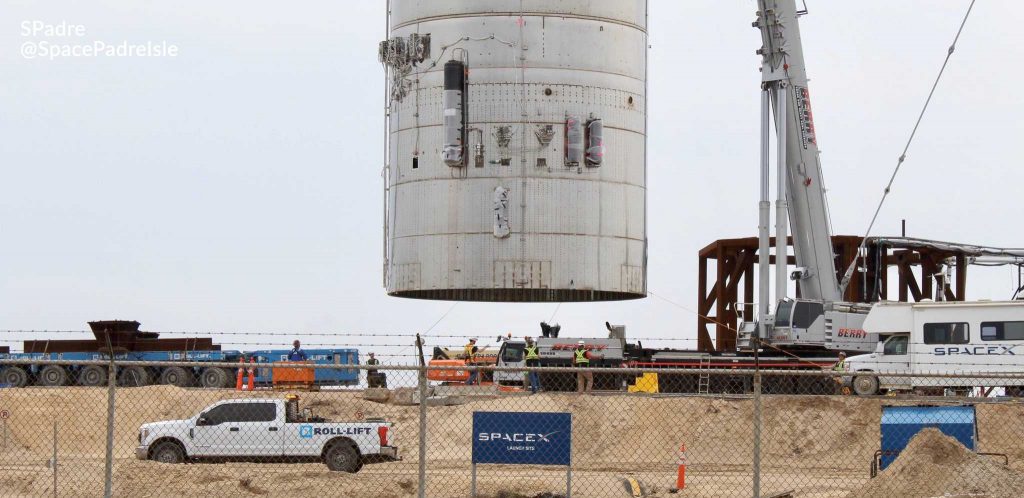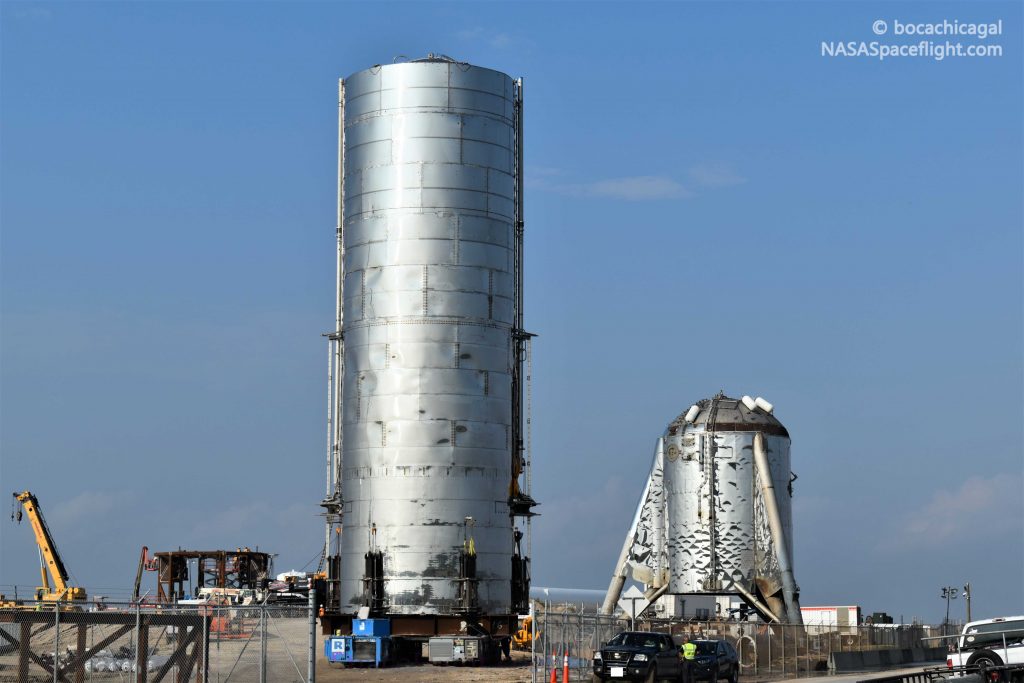SpaceX’s first flightworthy Starship prototype has rolled to its South Texas launch pad just hours after it was welded together and is now preparing for several critical tests it must pass before it can be deemed ready for liftoff.
Fabricated and assembled with incredible speed at SpaceX’s growing Boca Chica, Texas Starship factory and test facilities, the vehicle SpaceX moved to the launch pad earlier today (Feb 25) is meant to become the first full-scale Starship prototype to take flight. Following in the footsteps of the Starship Mk1 prototype, deemed too shoddy to launch and pressurized to destruction in November 2019, the first serial build (SN01) of an improved line of Starship prototypes appears to have taken less than a month to go from first weld to the launch pad.
CEO Elon Musk took to Twitter earlier today to confirm the Starship SN01 tank section’s move to the launch pad, further noting that the tank assembly is now preparing for Raptor engine installation ahead of a static fire test. According to NASASpaceflight.com, SpaceX wants to complete that static fire and launch Starship SN01 as early as next month – a seemingly improbable target that just got much more likely with the rocket’s tank section already at the launch pad. Most importantly, however, the speed with which SpaceX has been able to assemble and prepare Starship SN01 suggests that even if things go wrong or plans change, another completed prototype could be ready to head to the pad just a few weeks from now.
On February 25th, SpaceX CEO Elon Musk posted a screenshot taken from a livestream created by SPadre earlier that day, noting that Starship will soon have engines installed in preparation for a critical static fire test.

Under the cover of an incredibly thick fog bank, Starship SN01 was lifted onto a Roll Lift transporter and carefully moved from its factory facilities to SpaceX’s Boca Chica launch pad at 4:30 am PST. Around 7:30 am PST, the giant rocket tank was lifted onto the pad’s Starship mount and technicians have been working to connect SN01 to the ground systems ever since.
Built out of stainless steel, Starship SN01’s tank section – referring to the combined liquid oxygen tank, liquid methane tank, and engine section – stands about 30m (100 ft) tall and likely weighs at least 30-45 metric tons (~70,000-100,000 lb) as it stands. While SN01 is clearly missing its pointed nose section (‘nosecone’) and flaps, among other parts, its tank section has been moved to the launch pad to perform tests that don’t involve the ship’s aerodynamic properties.
Starship Mk1 – SpaceX’s first attempt at a full-scale prototype – was fabricated and stacked piece by piece over the course of nine months before its tank section – looking almost identical to SN01 – first rolled to SpaceX’s launch pad on October 30th, 2019. Three weeks later, it was intentionally pressurized until it popped after engineers concluded that its production quality was too low for a flight test attempt to be worth the effort. On the other hand, the first of Starship SN01’s steel rings was definitively completed in the last week of January 2020, quite possibly just four weeks before the completed tank section was rolled to the same launch pad.
With that kind of speed, it’s no surprise that Musk says SpaceX will start stacking Starship SN02’s tank section this week. Intriguingly, Musk also stated that Starship SN02 would have three Raptors installed, avoiding the original question’s focus (SN01). As such, it appears that Starship SN01 may only have one Raptor installed for a static fire test and would be unlikely to ever fly if that were the case. It’s possible that after two highly successful (and explosive) pressure tests of smaller Starship test tanks that were completed last month, SpaceX still wants to perform a similar pressure test with a fully-integrated, full-scale Starship tank section to confirm that the smaller tank results carry over.

Whether SN01 is still destined for flight, it’s safe to say that Starship SN01 tank testing could begin in a matter of days — SpaceX currently has early-morning roadblocks indicative of such testing scheduled from February 29th to March 2nd. SpaceX is likely to kick off by filling SN01 with water to check its tanks for leaks, followed by liquid nitrogen – chemically neutral but still incredibly cold. After that, SN01 would likely graduate to Raptor engine installation and a wet dress rehearsal (WDR) with liquid oxygen and methane before moving on to a static fire attempt, if all goes well.
Check out Teslarati’s newsletters for prompt updates, on-the-ground perspectives, and unique glimpses of SpaceX’s rocket launch and recovery processes.

(adsbygoogle = window.adsbygoogle || []).push({});
<!–
–>
var disqus_shortname = «teslarati»;
var disqus_title = «SpaceX Starship rolls to Texas launch pad ahead of next big test campaign»;
var disqus_url = «https://www.teslarati.com/spacex-starship-launch-pad-transport-test-campaign/»;
var disqus_identifier = «teslarati-130600»;

